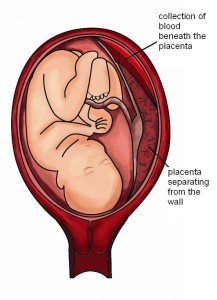Placental abruption
Diagram 1 Placenta abruption. Blood collection beneath the placenta
What is placental abruption?
What are the symptoms associated with placental abruption?
- Vaginal bleeding either a little or large in amount. This is usually associated with abdominal pain. In some women, the bleeding is concealed and there is no bleeding from the vagina at all.
- Reduced fetal movements
- Contraction pains.
Who are at risk of developing placental abruption?
- Smoking

- Cocaine drug user
- Women age > 35 years old
- History of placental abruption in previous pregnancy
- Pregnant with twins or more
- History of abdominal trauma
- Uterine abnormalities e.g fibroid beneath the placenta
- Premature preterm rupture of membranes (PPROM)
- History of chronic hypertension or preeclampsia
- Have underlying clotting disorder
- Too much amniotic fluid (polyhydramnios)
What are the complications associated with placental abruption?
- Disruption of blood and oxygen supply to the baby, causing the baby to be distressed and die in the womb
- Premature contractions leading to premature labor and delivery
- Problems with blood clotting in the mother leading to widespread internal bleeding called disseminated intravascular coagulopathy (DIVC). This could be potentially fatal for both mother and baby.
What is the treatment for placenta abruption?
RECOMMENDED BOOKS:
[easyazon-image align=”none” asin=”0761148574″ locale=”us” height=”160″ src=”http://ecx.images-amazon.com/images/I/61ehkftyEjL._SL160_.jpg” width=”109″] [easyazon-image align=”none” asin=”143917511X” locale=”us” height=”160″ src=”http://ecx.images-amazon.com/images/I/5199yh-%2BlzL._SL160_.jpg” width=”124″] [easyazon-image align=”none” asin=”1440528519″ locale=”us” height=”160″ src=”http://ecx.images-amazon.com/images/I/51K8MM96Y7L._SL160_.jpg” width=”138″] [easyazon-image align=”none” asin=”1554073804″ locale=”us” height=”160″ src=”http://ecx.images-amazon.com/images/I/5143oayY1iL._SL160_.jpg” width=”123″]








